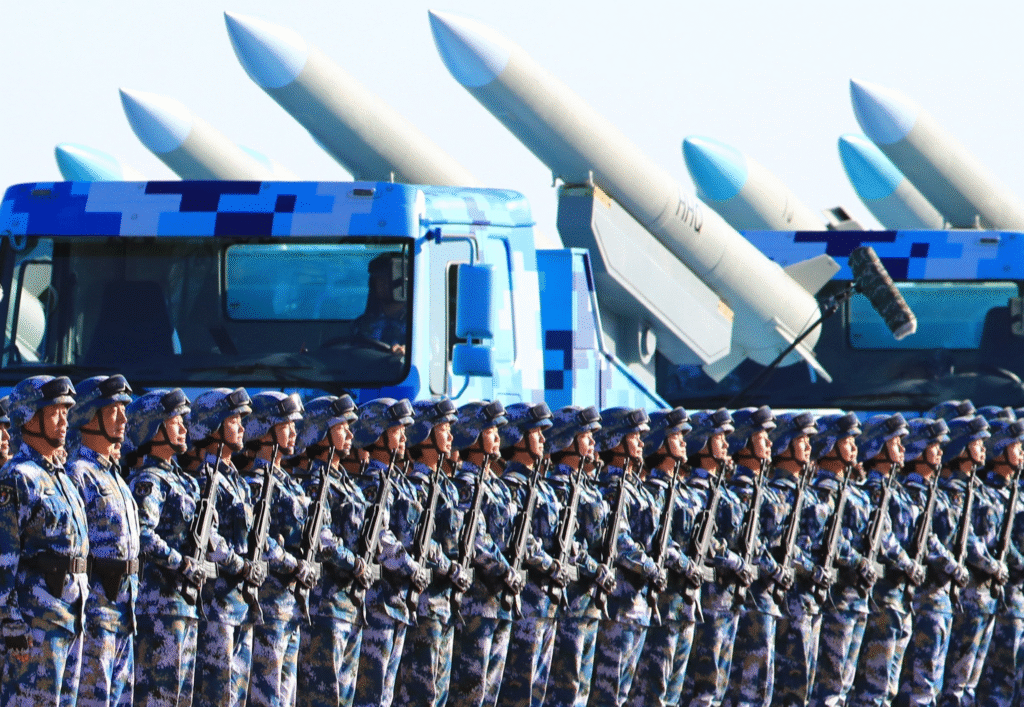China’s Newest ICBM Missile, the DF-61, Unveiled in Massive Military Parade
Discover China’s powerful new DF-61 ICBM, revealed at a recent military parade. This intercontinental ballistic missile boasts a 15,000 km range and advanced MIRV technology. Learn how this strategic weapon is changing the global military landscape
In a momentous and meticulously choreographed show of force, China has sent a powerful message to the world with the public unveiling of its new intercontinental ballistic missile (ICBM), the DF-61, during a recent military parade in Beijing. This event, far from being a mere commemoration, served as a stark and deliberate statement about China’s rapid military modernization, its growing global ambitions, and its commitment to a robust nuclear deterrent. The parade showcased an array of advanced weaponry, but the DF-61 stood out as the centerpiece, symbolizing a major leap in China’s strategic capabilities and signaling a new era of geopolitical dynamics.
The significance of the DF-61’s debut cannot be overstated. For decades, the United States and Russia have held a near-duopoly on global nuclear power. While China has possessed a nuclear arsenal for some time, it has been traditionally viewed as smaller and less sophisticated. The introduction of the DF-61 changes that calculus entirely. This new ICBM is believed to be a successor to the DF-41, China’s previous road-mobile ICBM, but with enhanced capabilities that directly challenge the technological superiority of its Western rivals. Military analysts and intelligence agencies across the globe are now scrambling to reassess China’s strategic readiness and its long-term objectives.

The DF-61 is a road-mobile, solid-fueled missile. This combination of features is critically important for its effectiveness. A road-mobile platform means the missile can be moved and launched from anywhere with a suitable road network, making it incredibly difficult for an adversary to locate and target. This mobility enhances survivability, ensuring that a significant portion of China’s nuclear deterrent could survive a first strike. The solid-fueled nature of the missile allows for a much quicker launch time compared to its liquid-fueled predecessors, reducing the window for a pre-emptive strike and increasing the credibility of China’s retaliatory capability.
Initial estimates of the DF-61’s specifications paint a picture of a truly formidable weapon:
Range: The missile is estimated to have a staggering range of up to 15,000 kilometers (9,320 miles). This places virtually every major city and military installation on Earth within its striking distance, including targets in the continental United States, Europe, and Australia.
Payload: Perhaps the most alarming feature of the DF-61 is its rumored payload. Experts believe the missile can carry multiple independently-targetable reentry vehicles, or MIRVs. Some reports suggest it could be equipped with up to 10 or more warheads. This MIRV technology allows a single missile to strike multiple targets simultaneously, significantly increasing the challenge for any existing or future missile defense system. An enemy would have to intercept each individual warhead, a task that becomes exponentially more difficult as the number of warheads increases.
The DF-61’s debut was not an isolated event. The parade also featured other new strategic systems, presenting a comprehensive picture of China’s evolving nuclear force. For the first time, China publicly displayed all three components of its nuclear triad:

Land-Based: The DF-61 and the upgraded DF-5C liquid-fueled ICBM were the stars of the show. The DF-5C, with an even greater reported range of over 20,000 kilometers, further solidifies China’s land-based strike capability.
Air-Based: The parade included the JL-1, a new air-launched nuclear missile, which can be deployed from strategic bombers. This adds a crucial layer of flexibility and surprise to China’s nuclear arsenal.
Sea-Based: While the parade was on land, it symbolically completed the triad by showcasing a scale model of a new submarine-launched ballistic missile (SLBM). China has been quietly building a fleet of advanced nuclear-powered submarines, and this display underscored its commitment to a powerful sea-based deterrent.
The public display of all three legs of the triad—land, air, and sea—is a deliberate message. It indicates that China is no longer content with a limited nuclear deterrent. It is pursuing a full-spectrum, survivable, and highly capable nuclear force designed to ensure its security and project power on a global scale.
The international community’s response to the parade has been a mix of concern and careful analysis. The United States, in particular, has viewed China’s military expansion with increasing alarm. A recent Pentagon report estimated that China’s nuclear stockpile could reach 1,500 warheads by 2035, putting it on a trajectory to achieve near-parity with the US and Russia. This projection challenges the long-held assumption of US nuclear superiority and introduces a new era of multi-polar nuclear competition.
The display also had significant diplomatic implications. While leaders from countries like Russia and North Korea were in attendance, showcasing a deepening alignment among geopolitical rivals, major Western nations were notably absent. This absence underscored the growing ideological and strategic divide between China and the democratic world. The parade served as a stark reminder of China’s defiance of international norms and its determination to pursue its own path, regardless of global opposition.
For countries in the Indo-Pacific region, the message was particularly pointed. The DF-61 and other long-range systems are not just aimed at the United States; they are also designed to deter any potential interference in conflicts over Taiwan or the South China Sea. The parade solidified the perception that China is building a military capable of dominating its immediate sphere of influence and projecting power far beyond its borders.

The unveiling of the DF-61 and the public display of China’s full nuclear triad has cast a dark shadow over the future of international arms control. For years, the US and Russia have been the primary signatories of treaties designed to limit the proliferation of nuclear weapons. However, China has consistently refused to participate in these discussions, arguing that its arsenal is purely for defensive purposes and is far smaller than those of the two superpowers.
With the DF-61, that argument is becoming increasingly difficult to sustain. The missile’s range and MIRV capability suggest an offensive, not just a defensive, posture. The display forces a re-evaluation of global security and raises fundamental questions about the stability of the international system. Will the US and Russia now feel compelled to accelerate their own nuclear modernization programs to counter China’s rise? Will the world enter a new and more dangerous arms race?
In conclusion, China’s military parade was more than just a public spectacle; it was a clear and unambiguous declaration of intent. The DF-61 is not just a new missile; it is a symbol of China’s growing power, a challenge to the existing world order, and a harbinger of a more complex and potentially unstable future. As the world grapples with the implications, one thing is certain: the global balance of power has shifted, and the days of a bipolar nuclear world are over.
Read Also : Indonesia Police Fire Tear Gas Near Universities as Protests Escalate: Thousands Rally Amid Growing Tensions








